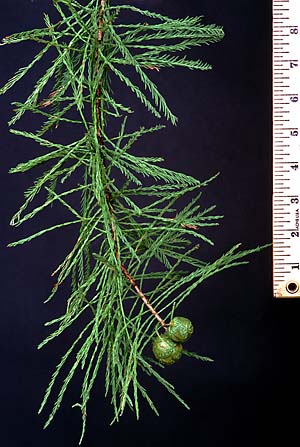Pond Cypress
Taxodium ascendens
Family: Cupressaceae
Natural History

Pond cypress (Taxodium ascendens) is closely related to bald cypress (Taxodium distichum). However, pond cypress typically prefers a more isolated, thriftier life style. For example, bald cypress thrives in communal linear swamps along nutrient rich rivers, but pond cypress is most frequently found in isolated depressions feed by nutrient poor, shallow ground water.
On average more than a quarter of the area of Florida's flatwoods is pocketed with shallow depressions, and these depressions have conditions that are ideal habitat for pond cypress. The depressions are fed by slowly seeping, acidic ground water and typically dry up once or twice a year. By contrast, bald cypress is found in higher pH, moving water, that doesn't dry up very often. Fire is more frequent in the dryer pond cypress habitat and pond cypress has thicker, fire resistant bark. However, both pond and bald cypress need a dry period for successful seed sprouting and survival.
The more frequent dry down of pond cypress habitat has an important benefit for some species. It prevents predatory fish from getting established and this allows frogs and other amphibians to thrive. In fact, some amphibians like the endangered flatwood's salamander will only lay their eggs in dry ponds. This ensures that no fish will be present to feast on its larva when the pond refills.
From a distance many pond cypress ponds have a domed appearance. On closer inspection it can be found that the trees in the middle and deepest part of the pond are the tallest, and they become progressively smaller away from the center of the pond. Scientists believe this results from conditions for cypress growth being better in the deeper part of the pond.
Both cypresses are known for their "knees" and buttressed trunks, but the biological function of these is as yet undetermined. Some studies have reported that they serve to supply oxygen to the roots of the trees and also anchor and support the tree in an unstable environment. Typically pond cypress trees have fewer knees and less buttressing than bald cypress trees.
